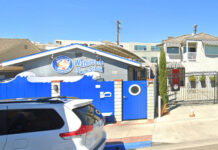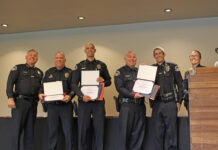Having read numerous articles and letters about the proposed ethnic studies elective course at Los Alamitos High School, I want to say that I hope it is implemented. I am confident that students will enjoy it and gain from it. I say this as an “outside observer” because I am neither a parent of a student, nor am I a professional educator. Even so, I hope the reader will stick with me for a few minutes because I have a story to tell.
I was young, college-educated, employed in a demanding professional career, recently-married and an avid student of American history when—much to my surprise—I discovered that the name “Manzanar” meant nothing to me. I had inquired of my then-wife how her parents had met.
Learning that their encounter occurred at Manzanar, we journeyed into the Owens Valley to visit it. There I started to understand how they, along with 120,000 others at Manzanar and nine other similar locations, spent a few years of their young lives. In a fit of wartime xenophobia afflicting the U.S. government and much of the nation’s population, they and their families were forcibly uprooted from their homes, leaving behind significant property and other items of value. My wife’s parents, along with most of the others incarcerated at Manzanar and the other camps, were U.S. citizens. But because they were Nisei, they did not look like the majority white American population, and so they were objects of suspicion and hostility.
This was not America’s finest hour. But it was a milestone in the anti-Asian prejudice and exploitation that had been part of the development and growth of the United States for the previous century and more. (Unfortunately, events of the last year regarding the origin of the corona virus pandemic have created an additional similar milestone.) And yet, my education had taught almost none of this history.
Learning from this delayed education helped to make me a better person. It gave me a better understanding of others who have backgrounds different from mine. Since this has been a national educational experience, I feel it has made the United States better, too. For any country much of its history is deserving of pride, but some is the stuff of shame. Nations that recognize and learn from their mistakes of the past will grow, change and prosper. Those that do not will, I think, be diminished.
The published remarks of the opponents to this ethnic studies class — a course that appears to be a telling of otherwise overlooked histories — seem to me to be based on a fear that it will subvert the telling of the American story as that of one undiluted success after another. If that is so, then I will concede that their fear is to one extent well-founded: education is the ignition of subversion. Learning history helps us to understand the mistakes of our past and how to benefit from the lessons of those mistakes. And, yes, education also provides the foundation and the tools necessary to subvert obstacles that are in the way of becoming better.
Most of what we have around us today is good. Let’s not get in the way of the young ones who want to learn how to take all around them that is worthy and add to it. My high school education was all the poorer for not telling the century-long story of the Manzanar episode. Curricular mistakes like that are too easy to make because there is so much history that needs telling. The proposed ethnic studies course cannot be expected to avoid all such mistakes, but I think it will be a big help and an educational step in a good direction.
Thanks for taking your time to read my story.
Sincerely,
Garry Herron
Seal Beach
We should all be concerned over increasingly harsher tones and opinions
I have read with interest the back and forth discourse regarding the Los Alamitos High School (LAHS) elective curriculum on ethnic studies. We should all be concerned over the increasingly harsher tones and opinions regarding the subject, potentially alienating individuals, family members, generations, neighbors, all small town citizens who should be tolerant and helping each other out when in need.
My perspective is coming from a background of having lived in Seal Beach for over 36 years, and with two now adult children, who received an excellent education (including the opportunity of participating in the then on-site Orange County High School of Arts [OCHSA] during their high-school years) within the LAUSD.
So, first the facts as per usnews.com. The high school is ranked #160 (top 10%) in California. Math proficiency is about 58%, and reading proficiency is above 80%. The student body is diverse, by ethnicity/race: 49% White, 26% Hispanic, 15% Asian, 6% 2 or more races, 3% black, 1% native Hawaiian/Pacific Islander, with 17% of students classified as economically disadvantaged.
Now for the hotly debated (by many from outside of our district, with no stake at all in the well-being of our children or our neighborhood) ethnic studies curriculum.
On the LAUSD website I could not find the LAUSD board-approved curriculum for the non-mandatory, elective ethnic studies course, which is available only for students who had al-ready taken history courses. After searching on Google, https://event-newsenterprise.com/lausd-ethnic-studies-curriculum-now-on-public-preview/ revealed the recommended material prior to approval. The basic course book was written by an acclaimed expert Ronald Takaki, with the text inclusive of a multicultural perspective (I browsed chapter titles, but confess of not having read the book). I had read the recommended article on white privilege by Cory Collins, which I have found factual. There is no material on Critical Race Theo-ry.
It would serve the LAUSD Board well to link the approved and final ethnic studies curriculum to the website for all to see.
Away from the subject of LAHS curriculum however, one should really pay attention to the previously approved non-mandatory Social Justice Standards “tool” aimed to assist with younger students, (available at losal.org). The “tool” helps teachers to address race and gen-der. When it comes to religion and health, however, it falls short on appropriate and time-relevant guidance, as illustrated below.
For K-2, a Christian girl’s situational conversation about being religious ends with “I can feel good about myself without being mean or making other people feel bad”. Why would a child even think that he/she should not be comfortable being a Christian? Having an in-school dis-cussion about being mean in this context probably intends to avoid expression of superiority to others. Such discussions however, primarily belong to the home of 5-7 year old kids.
For the 3-5 grade level, and example is a boy who always sits alone at lunch while frequently coughing. Two kids observing him plan to socialize with him to get to know him and make him feel better. The story implies that his loneliness and the cough is related to being disadvan-taged. As a physician, my first thought would be to be careful, help him with his cough through discussion with a teacher, who should then send the child to the school nurse for advice and the need for medical assessment. This example is particularly outdated during the pandemic.
A 6-8 Grade level scenario is particularly wrong in its message. Patrick is Christian, and he is interested in other religious beliefs and practices. He asks for advise from his Sunday school teacher, who assures him that he can be Christian and befriend and learn from people of dif-ferent religions. “In fact, the teacher’s best friend of thirty years is a Jewish woman she grew up with!” Teaching tolerance and explaining that different religions and people can coexist and respect each other is a must, but this example is equal to ‘I cannot be a racist because I have a Black, Asian, American Indian, etc, friend.’
While well-intended, with young kids-most of whom would describe a friend when asked about as wearing glasses, cool shoes, etc, rather than by race-being much more impressionable than high-schoolers, the Social Justice Standards is in need of serious revisions.
Back to LAHS and the recent correspondences: It is uncalled for a White student from LAUSD to feel the need to apologize for the privilege she inherited and for living in a nice neighborhood; her parents worked hard for such. On the other side, arguing that the curriculum will decrease property values is flying in the face of double digit price hikes in Seal Beach, Rossmoor, and all around us. What could decrease property values is the constant bickering and spiritually mili-tarized “discussions” on any subject, be that education, race, religion, or inequality, not to mention politics, regardless of the originating side, particularly if the intent is making our great and so far safe neighborhood the center of uncontrolled mob scenes. It is great news that fis-cal restrains disallowed a potentially self-induced riotous scenario regarding the meeting “to educate” us.
I would like to express my appreciation to the Sun editorial staff for the objective journalistic reporting of the story behind the Orange County Board of Education and the Rossmoor Board discussions. The Sun’s Jul. 15 issue provided an inspiring and reassuring example of com-mendable, civilized, diverse, tolerant, peaceful coexistence by having articles on the Jewish Family and Children’s Service, Calvary Chapel baptism, and a Jehovah’s Witnesses virtual event, in addition to the Annual Sunset Pancake Breakfast, adjacently printed to each other.
We should all agree that the overriding aim of the board and LAUSD is to further the educa-tional level-for example, set goals including ranking at least in the top 100 in California-through substantially improved math and reading proficiency, provide a safe and mutually respectful environment, allocate additional resources for all students, and, particularly for those of great-er needs for whatever reason. Our state budget surplus should provide additional financial assistance for LAUSD, so we can let the educators focus on teaching and better preparation of the next generation for the future in an ever-more diverse society that increasingly puts a premium on applicable knowledge.
George Somlo, MD
Seal Beach
Supports community pool
As a 50+ year resident of Seal Beach I would like to add my name to the list of those who support a community pool in Seal Beach. I really can’t imagine living here without one. Both my daughters learned to swim at McGaugh. They then joined the Seal Beach Swim Club, swam competitively at Los Alamitos High School, and returned to teach swimming and lifeguard. I have been a lap swimmer for over 40 years and I have valued the opportunity to maintain my health and fitness. The pool has been a big part of our lives and the lives of other families in Seal Beach, providing safe and healthful activities.
This pool is used year round by a variety of citizens for lap swimming, swim lessons, recreational swimming, training for the junior guard program, water aerobics, swim teams, water polo groups, rehabilitation, birthday parties and general fitness and well-being. It is a great asset to Seal Beach.
Seal Beach has always been a family-friendly city. A community pool enhances our property values and reaffirms that the City is committed to the well being of our children and family members of all ages.
I strongly urge the City Council members to find a solution and maintain a community pool in Seal Beach.
Sally Champlin
Why Old Town needs a pool in Old Town
Our family has a long-standing relationship with the community pool on the McGaugh campus. Summer swim lessons at the pool during the ‘90s laid the foundation for years of competitive swimming, lifeguarding, and swim instruction. We currently attend lap swim multiple times a week. Regarding the community pool project, we would like to expand on a few key points that should be clarified to the ENTIRE Seal Beach community (Old Town and otherwise):
Those of us who swim at McGaugh Pool regularly are dedicated to the sport and the facility. We rely on the pool for the fitness, health, safety, and society of ourselves and our families. This includes not only Old Town/Hill residents, but also residents of Surfside, Huntington Beach, and Long Beach, many of whom work nearby and come to the pool as part of their workdays.
Learning to swim is a critical life skill, especially in beach communities like ours. We need a pool in which “learn-to-swim” programs are a key feature, so our kids and grandkids can achieve water safety.
Swimming is an excellent way to build cardiovascular endurance, according to the CDC, and develops whole-body fitness. The pool environment allows people to boost their health and immunity through exercise, and the chlorinated water makes it a more sanitary environment than other fitness facilities. Additionally, the low-impact nature of water exercise makes it an ideal choice for individuals who are elderly or have limited mobility.
Many local aquatic “legends” first learned to swim at community pools such as the one on the McGaugh property. In fact, one such young woman is headed to her second Olympics this summer! We need a pool that serves the local community, first and foremost—a place where swimmers of all ages and skill levels will want to come and bond over their shared love of aquatics.
Many local patrons have been saying we don’t want—or need—a pool in Old Town because we already have pools in Leisure World and at the Joint Forces Training Base. With all due respect, these individuals are speaking without understanding the deeply ingrained routines that shape the lives of everyone in the McGaugh Pool “family.” We literally schedule our lives around daily lap swims and summer lessons for our kids, and having these activities within walking and cycling distance, at the center of our Old Town and Hill communities, is extremely important. Leisure World and Rossmoor/Los Al have their own local aquatic facilities, and the Old Town community deserves no less.
Most of our fellow pool patrons would probably agree that we don’t need or want to be the next Belmont Plaza Pool. We’re not asking for aquatic playgrounds or 10-meter diving platforms. We just want an easily accessible (and functioning) pool where we can enjoy lap swimming and aquatic fitness, where we can safely bring our kids, and where we can continue to share our love of the water with our Old Town neighbors and friends. We understand that cost concerns exist, but entirely removing a local pool from Old Town Seal Beach would come at too great a cost to us all—the costs of our physical wellness, our water safety, and our strong swim community.
If you are skeptical, we invite you to come see the pool for yourself! Drop by at any hour of the day, meet our lap swim community, watch the kids learning new skills, and then determine whether this project should continue!
Lori Stanley
Old Town Seal Beach












